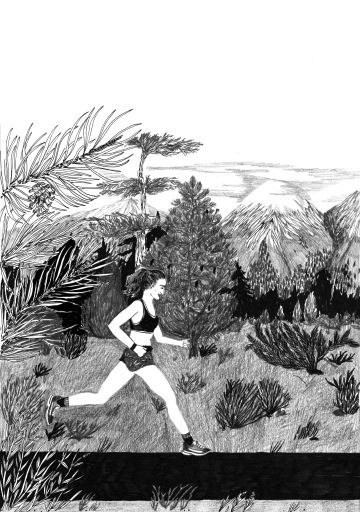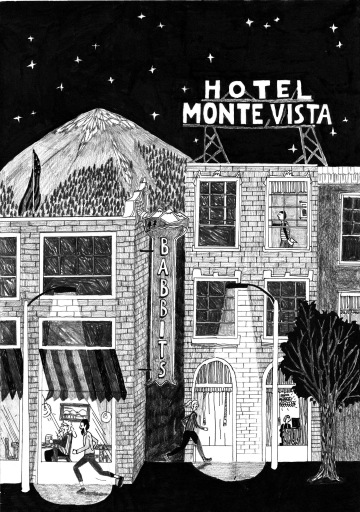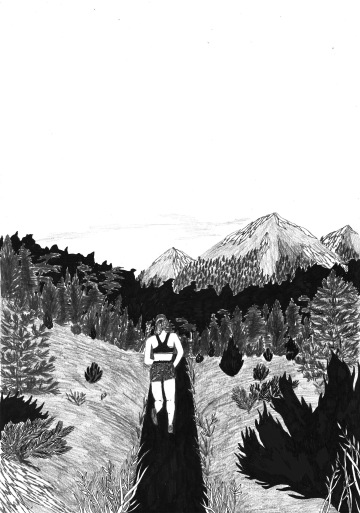Disappearing, Thanks to Flagstaff’s Magic
The nights in Flagstaff, Arizona are pitch black. Stars pop brilliantly against a backdrop of complete darkness. The street lamps are purposefully dim, only using a certain orange light that throws a ring of visibility around the smallest possible circumference of sidewalk. And almost all businesses are closed by ten or eleven PM. It’s so dark and the air is so still that when you stand in your yard and throw your head back to look up at a wide open sky dotted with starlight, it gives you the sense that you’ve disappeared.
And in a way, Flagstaff does make you disappear. It forces you to live within its bubble. A bubble where the important things in life are usually: what split you hit at the end of your tempo on Lake Mary Rd., or how many hours of sleep you can get at altitude, or what your total weekly mileage was and what kind of terrain you ran it on. A bubble where the normal grueling grind of city or cookiecutter tedium of suburban life doesn’t quite reach you. Flagstaff hovers in between the two, somewhere removed from it all.
It’s the second snowiest city in the contiguous U.S., among the highest up in terms of altitude, and also somewhat paradoxically, plopped down in the middle of the driest, hottest, least conventionally hospitable region of the United States – the Southwest. Flagstaff has become a college town. But it has always been a place with great significance for Navajo, Hopi, Havasupai, Yavapai, Kaibab-Paiute, and Hualapai Native Americans. It’s also now a city where wealthy Southwesterners go to retire. Other than that, it mainly attracts tourists on the way to the Grand Canyon, and endurance athletes.
Because Flagstaff is a place where runners can hole up to become fit. Where running is one of the main concerns of a good chunk of the population. That’s the reputation, at least, of the city of about 71,000 these days. Among runners, Flagstaff has become an indispensable training camp location. Elite ultramarathoner, trail runner, U.S. Olympic marathon trials qualifier, running coach, and Flagstaffian Stephen Kersh explains that, “Flagstaff exists as one of the last places where you can really have a singular purpose if you choose to. It's easy to cut out any distraction in this town, and that's what makes it such a special place to live and train. Maybe it's because to live and train can really just be one word in Flagstaff. If you're living here, you're training.”
Flagstaff’s elevation as a mountain town of about 7,000 ft (2,100 m), and its access to a wide range of ideal running surfaces – from tracks, to trails, to gravel, to cinder, to roads, to mountain paths – makes the city seem like it was almost built to be a haven for runners who want to put their heads down and focus without interruption, solely, on their craft. The city itself has fed into this obsession with running. Flagstaff City Hall (which calls itself Team Flagstaff on its website) boasts about the development of its Flagstaff Urban Trail System (FUTS). The FUTS is a city-wide network of dirt and gravel paths that cut through town, for running – and I guess if you really wanted, cycling or walking, too. It currently consists of 56 miles of trails, with plans to open up 75 more. That’s a lot of trail.
In the summer, a local pizzeria gives any person who makes it to the top of Mt. Elden, which sits at 9,298 feet, before 7:00 AM a ticket for a free pizza later that day. This is all to say, that the town – city sometimes seems like an overstatement – is very much aware of the power that running has over it. The government, the people all seem to embrace it. After all, some cities swell with tourists during certain times of the year. Flagstaff swells with runners in the lead up to big races.
As the 2020 Olympics draw closer, I can’t help but remember a sign hanging in one of Flagstaff’s prominent training centers – HYPO2. In text bubbles listing names, sport, and nationality, the sign showed the number of athletes who competed in the 2016 Olympics that came to Flagstaff to train beforehand. It listed the majority of U.S. Olympic runners, but it spanned across countries, nationalities, and sports until almost every inch of space was covered with a bubble.
In fact, the Olympics are a crucial point in Flagstaff’s story of becoming a training hub for endurance athletes. When the 1968 Olympics were slated to be held in Mexico City, athletes were understandably apprehensive about having to race at over 2,100 m of elevation. Many of those athletes, from around the world, sought out Flagstaff as an altitude environment where they could prepare for high profile competition. And that hasn’t gone away.
Spotting an Olympic gold medalist in line at the local coffee shop is almost commonplace in Flagstaff. People who aren’t entirely embedded in the running scene might not recognize star athletes who arrive in town, but they also aren’t shocked when they hear that the person in front of them is an elite endurance athlete.
But, the ebb and flow of insanely talented, competitive runners into Flagstaff has made the head-down, in-a-hole approach to training while there even more drastic. Because most runners come and go in alignment with their own schedules, any continuity of community is hard to come by. Even the runners and athletes who do live in Flagstaff full time tend to do their own thing, in small groups if they’re part of a team, or sometimes just entirely by themselves. Recreational runners might meet once or twice a week in structured settings at the track, or for an easy run. But in general, there just isn't much of an infrastructure for the non-Olympic caliber, more casual runner in town – you won't find many local 5K races tearing through the streets on Saturdays here. Flagstaff’s running scene is tailored to high performing individuals. This priority on the individual brings me full circle, right back to that feeling of disappearing in Flagstaff.
Because if you’re doing your own training runs in Flagstaff, they’re most likely going to be on a quiet, wooded trail where you won’t bump into too many other people in general. You could go days without seeing groups of other runners as you train, even though you know they’re there. And that ability to fade into the background, to disappear from view (at least in real life, if not on social media) is part of the allure of Flagstaff, I think. Once you’ve faded into the background, you don’t face the same noise or distraction from training that you might otherwise. You can strip running down to its core nature – one person moving their body forward through space and time as quickly as possible, and sometimes for as long as possible at that speed.
Running in Flagstaff becomes even more of a moving meditation than running elsewhere. In Flagstaff, you’re tuned into the nature of every step you take, the essence of what you’re doing, in an almost cloistered, monastic way. It’s not just the small-town lack of bustle feeling that gives running in Flagstaff an air of reclusiveness. It’s the actual isolation of the running areas, too. The best places to run in Flagstaff are almost all old logging roads or trails high up in the woods, apart from any element of the town.
Stands of towering pine trees give way to fields of grass and wildflowers, and red dirt beneath your feet. You can weave through trails barely etched into the ground for hours at a time and not have to double back to run the same place twice. To escape into the landscape, with no hint of civilization anywhere around you for that long, and then to be able to walk into town for a beer a few hours later, is surreal.
This chance to entrench yourself deeply into your own training, to rediscover your individual journey in the sport of running, may be the ultimate magic of Flagstaff. It’s a place where, if you live there, you go through months of head-down training at a time, until you’re ready to emerge on a starting line and shock competitors, and the world, with your fitness. If you go to visit, you disappear off the grid for a month or so, and come back to real life just slightly out of touch with the urgency of current events, or the latest meme, but a whole lot fitter and more connected to why you started running in the first place.
The way Kersh puts it is pretty much spot on: “I've lived here through the highs of my running and the lows. When everything is clicking, I don't think there's a place I'd rather be. But when you're injured, tired, or don't give a shit about running, it becomes a lonely, small place. Killing time in this town is straight murder.”
–––
Czech translation of the article was published in B magazine, issue 7 (spring 2019).


